
塩釜神社
再生のあかしの塩は白く清い
Salt That Indicates Recovery Shiogama Shrine
私たち人間は、塩を海から得てきた。塩は、古今東西、文化や宗教を越えて、清めの存在であり、人の生活に欠かせないものだ。
日本の多くの場所でそうであったように、水俣でも江戸時代以来、製塩が盛んにおこなわれてきた。ここ塩釜神社では、塩づくりの神様が祭られている。
近代化の中で製塩業はすっかりすたれてしまったが、水俣病からの再生の中で、もう一度、製塩を!という動きが始まった。今でも、水俣の海の潮にこだわる。いのちをいただいてきたこの海を感じ続けるために。
(by Minamata Impact)
Shrines are temples of Shinto, an ancient Japanese religion. This shrine, Shiogama Shrine, is dedicated to the god of salt making.
We humans have always obtained salt from the sea. Salt has been an essential part of human life since ancient times.
As in many places in Japan, Minamata had also been actively engaged in salt production since the Edo period.
During the modernization of the city, the salt manufacturing industry had completely disappeared. However, as the city was recovering from the environmental pollution, a movement to revive salt manufacturing began. Even now, they insist on using salt from the sea in Minamata, so that we can continue to feel the sea that has given me life.
(by Minamata Impact)
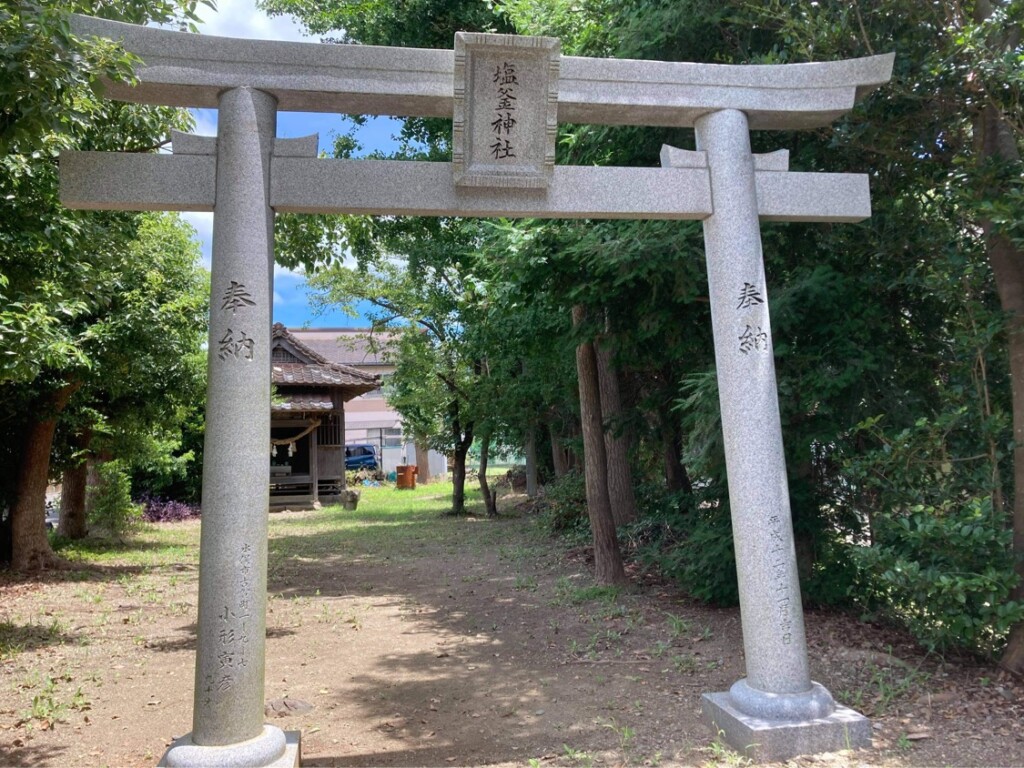
以下、水俣市企画・監修「水俣堂々」より抜粋。
The following is an excerpt from “Minamata Dodo” planned and supervised by Minamata City.
塩浜町に塩釡神社という神社がある。読んで字のごとし、かつて江戸時代以来、このあたり一帯は製塩がさかんに行われていた。神社に祀られているのは塩づくりの神様だ。
むかしは境内も広く、あたりの塩田よりも高台にあり、枝を広げた老松が緑の固まりとなり、遠くからでも離れ小島のように浮かんで見えたという。塩田の重労働に従事する人びとの得がたい安らぎの場だった。
 In Shiohama Town, there is a shrine called Shiogama Shrine. This area has been involved in salt production since the Edo Period, and the god enshrined at Shiogama Shrine is the god of salt production.
In Shiohama Town, there is a shrine called Shiogama Shrine. This area has been involved in salt production since the Edo Period, and the god enshrined at Shiogama Shrine is the god of salt production.
Long ago, the shrine had much more space, and was located on a hill above the saltpans. Surrounded by the branches of old pine trees tangled together in a green mass, it looked from far away like a floating island. It was a place of rare respite for those workers who performed heavy labor in the saltpans. In September, on the day of the festival, they would have the day off from work, and would pack lunches and watch sumo wrestling at the shrine.
9月の祭日となると、仕事は休み。ごちそうを持ち寄って相撲見物だ。境内には土俵がつくられて おり、そう、塩もある。相撲は代表的な神事なのだ。近郊の力自慢の若者たちが集まり、ハッケヨイノコッタ。初秋の佳き一日だった。
There was a sumo ring on the shrine grounds, and of course, salt. Sumo is one of the best-known Shinto rituals. Young men would gather from the surrounding areas to show off their strength. It was always a good day.

水俣の塩づくりを再現してみようじゃないか、と言い出したのは19区寄ろ会会長の廣島康雄だ。「地区寄ろ会」の活動案としてである。おおいに賛同を得た。善は急げ、平成4(1992)年からさっそく開始する運びとなった。
「ところが、塩づくりについてだれもがまったくの無知ということに気づいた。さあ困った」
むかしのことを伝え聞いている古老に教えを請い、やってはみるものの、これがたいへんむずかしい。失敗の連続だ。白いはずの塩がどうやっても茶色に薄汚れている。
 It was the Chiku Yorokai neighborhood association that began trying to revive salt production in Minamata. The group’s representative explains, “We quickly realized no one knew anything about salt production. What were we to do?” They asked older residents who knew of the area’s past to teach them, but even then salt production was very difficult, and they failed repeatedly. The salt, which was supposed to be white, would always come out a bit dirty, tinged in brown.
It was the Chiku Yorokai neighborhood association that began trying to revive salt production in Minamata. The group’s representative explains, “We quickly realized no one knew anything about salt production. What were we to do?” They asked older residents who knew of the area’s past to teach them, but even then salt production was very difficult, and they failed repeatedly. The salt, which was supposed to be white, would always come out a bit dirty, tinged in brown.
「明治の塩って、こんなもんだったのかなあ」
「うーむ、こんなものかもしれない」
そんなはずはないのだが、みんな手探りなのだ。試行錯誤はつづく。廣島は多忙ななかをやりくりし、なんとかいい塩をとがんばった。やがて、晒しで濾すことでひとつ視界が開けた。塩らしくなった。
「いまではみんな上手になりましたとも。品質はいいですよ。どこに出しても負けない、と自信を持っとる」
They continued with trial and error, and discovered that the salt needed to be filtered. The result looked more like salt as they knew it. “We’ve all become quite good at it now. The quality is good. We’re confident that it’s better than any other salt out there.”

海水を汲み上げ、砂を敷いた塩田にまく。これを天日で干すと砂に塩の結晶がつく。この砂を集めて塩水で溶かし( 灌水)、濃縮塩水を釡で焚く。煮詰まってきたらまた塩水の灌水、また焚く。まさにずっと焚き、釡を覗いている時間が大半ともいえる。
「一回の作業で、飛散も多いのでそうだなあ12〜13キロぐらいできるだろうか」だれもが本業を抱えているので年に3回ほどの製塩業だ。とても量産とはいかない。
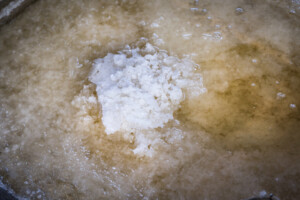 Seawater is drawn, and sprayed on a saltpan lined with sand. Dry this in the sun, and the salt crystallizes on the sand. The salt is then dissolved with saltwater. The concentrated saltwater is cooked in a pot, after which more saltwater is added, and the concentrate is cooked some more, and so on. The majority of salt production is spent keeping an eye on the pot. “A good amount of the salt gets scattered in the process, so one round yields around 12–13 kilograms.”
Seawater is drawn, and sprayed on a saltpan lined with sand. Dry this in the sun, and the salt crystallizes on the sand. The salt is then dissolved with saltwater. The concentrated saltwater is cooked in a pot, after which more saltwater is added, and the concentrate is cooked some more, and so on. The majority of salt production is spent keeping an eye on the pot. “A good amount of the salt gets scattered in the process, so one round yields around 12–13 kilograms.”
ただ一点、メンバーたちがこれだけは大原則としていることがある。海水は水俣湾のものにかぎる。海の水ならどれでも塩になるのだが、そこだけは譲れない。なぜならば、
「この塩が、水俣の海の再生の象徴を担うからです」
Since the members of the neighborhood association all have jobs, they are only able to make salt three or so times a year. It is far from mass-produced. One fundamental rule the group always adheres to is that the seawater must be from Minamata Bay. Any seawater will yield salt, but only by adhering to this rule are they able to produce salt that also symbolizes the recovery of Minamata’s sea.
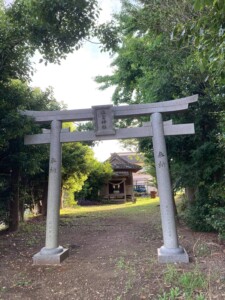 塩釜神社
塩釜神社
熊本県水俣市塩浜町
Shiogama Shrine
Shiohama-cho, Minamata, Kumamoto
コメント ( 0 )
トラックバックは利用できません。











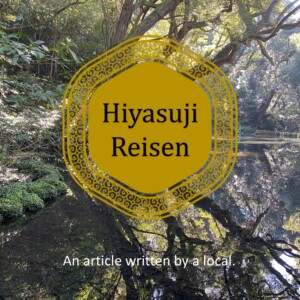



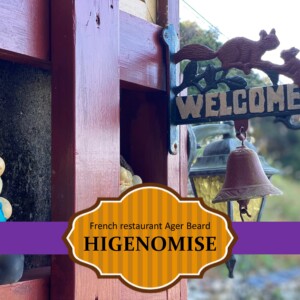

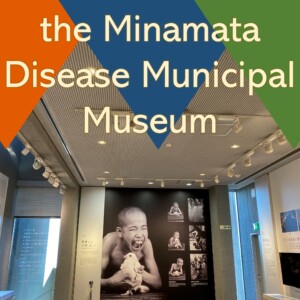

この記事へのコメントはありません。